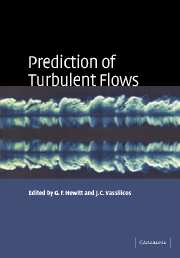Book contents
- Frontmatter
- Contents
- 1 Introduction
- 2 Developments in the understanding and modelling of turbulence
- 3 RANS modelling of turbulent flows affected by buoyancy or stratification
- 4 Turbulent flames
- 5 Boundary layers under strong distortion: an experimentalist's view
- 6 Turbulence simulation
- 7 Computational modelling of multi-phase flows
- 8 Guidelines and criteria for the use of turbulence models in complex flows
2 - Developments in the understanding and modelling of turbulence
Published online by Cambridge University Press: 12 August 2009
- Frontmatter
- Contents
- 1 Introduction
- 2 Developments in the understanding and modelling of turbulence
- 3 RANS modelling of turbulent flows affected by buoyancy or stratification
- 4 Turbulent flames
- 5 Boundary layers under strong distortion: an experimentalist's view
- 6 Turbulence simulation
- 7 Computational modelling of multi-phase flows
- 8 Guidelines and criteria for the use of turbulence models in complex flows
Summary
Abstract
Recent research is making progress in framing more precisely the basic dynamical and statistical questions about turbulence and in answering them. It is helping both to define the likely limits to current methods for modelling industrial and environmental turbulent flows, and to suggest new approaches to overcome these limitations. This chapter had its basis in the new results that emerged from more than 300 presentations during the programme held in 1999 at the Isaac Newton Institute, Cambridge, UK, and on research reported elsewhere. The objective of including this material (which is a revised form of an article which appeared in the Journal of Fluid Mechanics – Hunt et al., 2001) in the present volume is to give a background to the current state of the art. The emphasis is on the physics of turbulence and on how this relates to modelling. A general conclusion is that, although turbulence is not a universal state of nature, there are certain statistical measures and kinematic features of the small-scale flow field that occur in most turbulent flows, while the large-scale eddy motions have qualitative similarities within particular types of turbulence defined by the mean flow, initial or boundary conditions, and in some cases, the range of Reynolds numbers involved. The forced transition to turbulence of laminar flows caused by strong external disturbances was shown to be highly dependent on their amplitude, location, and the type of flow.
- Type
- Chapter
- Information
- Prediction of Turbulent Flows , pp. 5 - 49Publisher: Cambridge University PressPrint publication year: 2005



